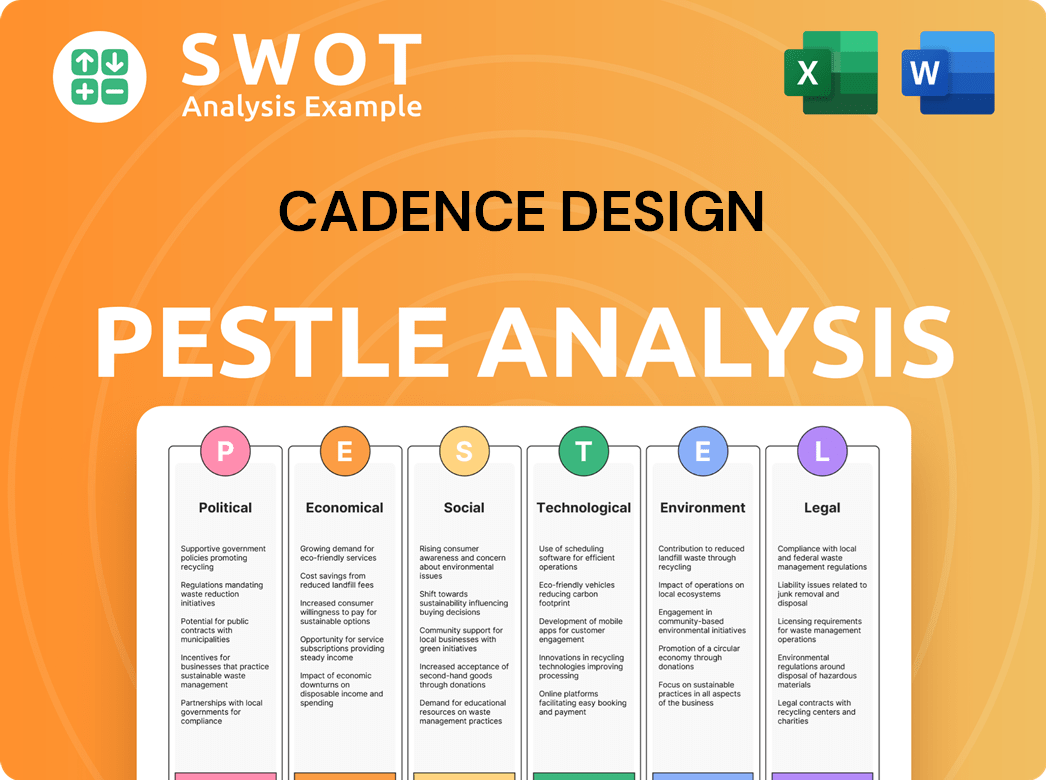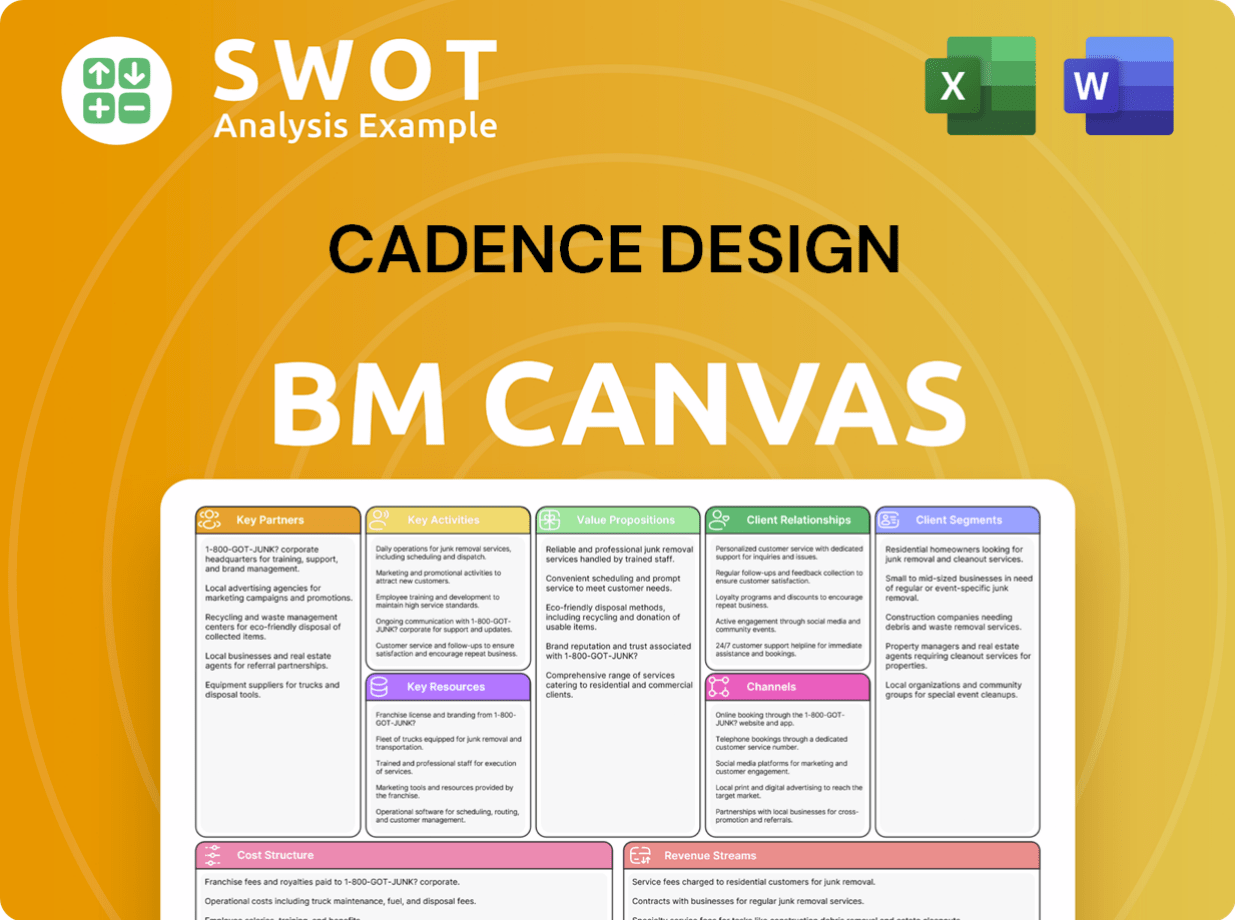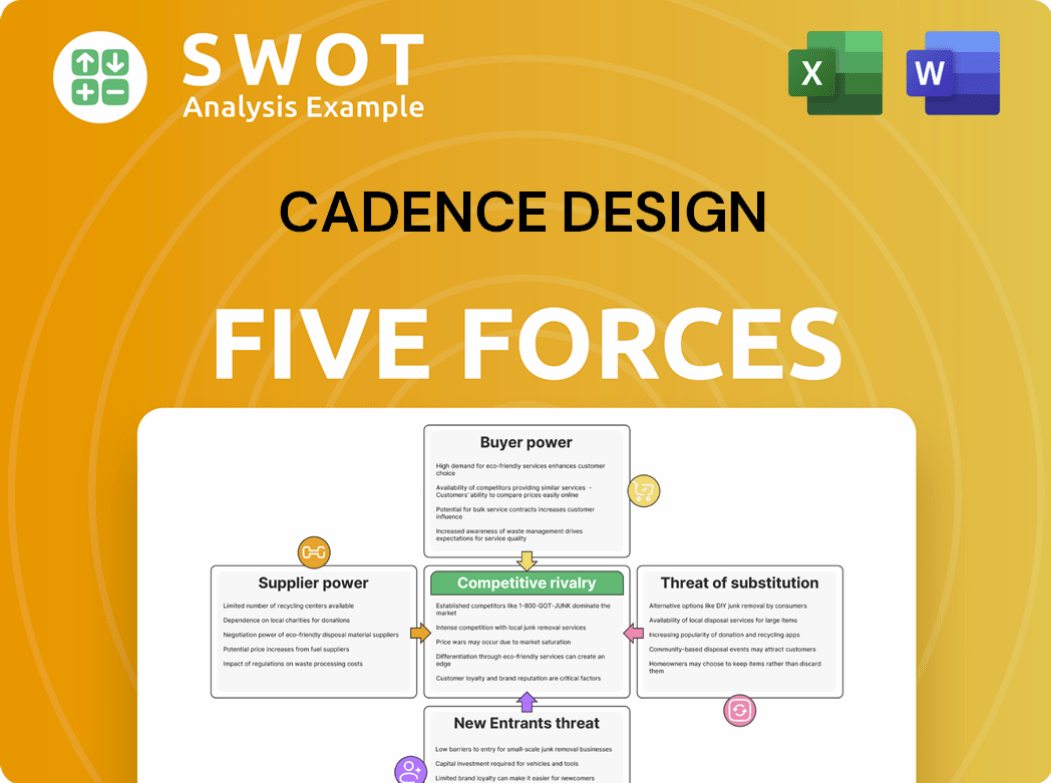Cadence Design Bundle
How Does Cadence Design Systems Dominate the EDA Market?
Explore the dynamic sales and marketing strategies propelling Cadence Design Systems, a titan in electronic design automation (EDA). From its inception, Cadence has navigated the complex landscape of technological innovation and customer needs, evolving its approach to maintain a leading edge. This analysis dives deep into the tactics behind Cadence's sustained success, revealing how it captures and retains its market share.

The EDA industry's growth, fueled by advancements in AI and automotive systems, highlights the importance of understanding Cadence's Cadence Design SWOT Analysis. This examination will dissect Cadence Design Systems' sales strategy, marketing strategy, and overall strategy, including its customer acquisition strategy and marketing campaigns analysis. We'll uncover the specifics of its go-to-market strategy, pricing strategy, and how it competes in the competitive landscape, offering actionable insights for anyone interested in the EDA software marketing or electronic design automation sales.
How Does Cadence Design Reach Its Customers?
The sales and marketing strategy of Cadence Design Systems centers on a multi-channel approach designed to reach its specific customer base effectively. Cadence primarily uses a direct sales force to engage with its clients, which are mainly semiconductor companies, electronics manufacturers, and research institutions. This strategy is crucial given the technical nature of its electronic design automation (EDA) software, hardware, and intellectual property (IP).
Direct sales teams at Cadence engage in in-depth technical discussions, provide customized solutions, and offer extensive post-sales support. This support is critical for complex enterprise-level software deployments. Cadence's direct sales model allows it to build strong, long-term relationships with its customers. This approach helps the company understand their specific design challenges and offer tailored solutions. This channel remains central to its revenue generation.
In addition to its direct sales efforts, Cadence leverages strategic partnerships and a limited number of authorized distributors. These partnerships are particularly important for expanding market reach in emerging territories. The evolution of Cadence's sales channels has largely been driven by the increasing complexity of electronic designs and the global expansion of the semiconductor industry. As of 2023, Cadence reported revenue of $4.09 billion, a figure significantly influenced by its sales strategy.
Cadence relies heavily on a direct sales force to interact with its customers. This approach is crucial for providing technical expertise and customized solutions. Direct sales teams are essential for managing complex enterprise-level software deployments.
Cadence forms strategic partnerships and uses authorized distributors to extend its market reach. These partnerships are especially important in emerging markets. Collaborations with cloud service providers like AWS and Microsoft Azure are also key.
Cadence uses digital strategies to support its direct sales efforts. This includes online demonstrations, virtual events, and digital content. These digital tools help educate potential customers and streamline the sales process.
Cadence offers cloud-based EDA solutions through partnerships with cloud service providers. This provides customers with greater flexibility and scalability. The Cadence CloudBurst Platform is an example of this, allowing rapid scaling in the cloud.
Cadence's sales strategy focuses on direct engagement, strategic partnerships, and digital tools to support its sales process. The company's approach is tailored to the complex requirements of its customers in the semiconductor and electronics industries. The company's focus on direct sales allows for building strong customer relationships and providing tailored solutions.
- Direct Sales: The primary channel for engaging with customers and providing technical expertise.
- Strategic Partnerships: Collaborations with distributors and cloud providers to expand market reach.
- Digital Engagement: Using online tools to support sales and educate potential customers.
- Cloud Solutions: Offering cloud-based EDA solutions for flexibility and scalability.
Cadence's sales and marketing approach is designed to align with its target audience, as detailed in the Target Market of Cadence Design article. The company's strategy is built to meet the specific needs of its customers. This includes providing comprehensive support and customized solutions. This focus on direct sales and strategic partnerships helps Cadence maintain a strong position in the competitive EDA market.
Cadence Design SWOT Analysis
- Complete SWOT Breakdown
- Fully Customizable
- Editable in Excel & Word
- Professional Formatting
- Investor-Ready Format

What Marketing Tactics Does Cadence Design Use?
The marketing tactics employed by Cadence Design Systems are a blend of digital and traditional strategies. These tactics aim to increase brand awareness, generate leads, and drive sales in the electronic design automation (EDA) industry. The company focuses on educating its highly technical target audience and establishing itself as a thought leader in the field.
Cadence's marketing strategy heavily relies on digital channels, including content marketing, search engine optimization (SEO), and paid advertising. These efforts are complemented by traditional methods such as industry events and public relations. The company's approach is data-driven, utilizing customer segmentation and marketing automation to personalize its outreach and measure campaign performance.
Cadence Design Systems' sales strategy and marketing strategy are designed to reach engineers and decision-makers. The company uses a multi-faceted approach to stay competitive in the EDA software market. This strategy is crucial for maintaining and growing its Cadence market share.
Cadence publishes technical white papers, application notes, case studies, webinars, and expert blogs. This content educates the target audience and establishes the company as a thought leader. Content marketing is a key component of how Cadence Design Systems sells its products.
SEO ensures technical content ranks highly, driving organic traffic. Paid advertising targets industry-specific platforms and digital campaigns. Cadence Design Systems marketing campaigns analysis reveals a focus on new product launches and technological advancements.
Email marketing nurtures leads with updates on software releases, events, and resources. Social media, especially LinkedIn, targets engineers and decision-makers. This approach is part of Cadence Design Systems' sales and marketing approach.
Cadence has a strong presence at events like the Design Automation Conference (DAC). Public relations efforts secure coverage in industry publications. These activities are critical for Cadence Design Systems' customer acquisition strategy.
Cadence uses customer segmentation based on industry and design needs. Marketing automation platforms and CRM systems manage leads and track campaign performance. This data-driven approach is central to Cadence Design Systems' go-to-market strategy.
Cadence engages with key opinion leaders and experts. This engagement often includes joint presentations at conferences or collaborative technical papers. This strategy helps to establish Cadence as a leader in the Electronic design automation sales.
Cadence's marketing strategy is dynamic, adapting to changes in the engineering community's information consumption habits. The company's marketing mix emphasizes digital engagement and thought leadership. For a deeper dive into Cadence's overall business strategy, including its growth initiatives, consider reading about the Growth Strategy of Cadence Design. The company's focus on innovation and customer engagement has contributed to its strong market position, with revenue consistently growing. For example, in Q1 2024, Cadence reported revenue of approximately $1.04 billion, reflecting continued demand for its EDA solutions.
Cadence employs a variety of marketing tactics to reach its target audience. These tactics are designed to build brand awareness and drive sales within the EDA industry.
- Content marketing, including white papers and webinars.
- SEO and targeted digital advertising campaigns.
- Email marketing to nurture leads and provide updates.
- Participation in industry events and trade shows.
- Strategic public relations and media coverage.
Cadence Design PESTLE Analysis
- Covers All 6 PESTLE Categories
- No Research Needed – Save Hours of Work
- Built by Experts, Trusted by Consultants
- Instant Download, Ready to Use
- 100% Editable, Fully Customizable

How Is Cadence Design Positioned in the Market?
Cadence Design Systems positions itself as a leading innovator in electronic design automation (EDA). Its brand strategy centers around 'Intelligent System Design,' helping engineers develop complex electronic systems efficiently. This approach targets semiconductor companies and system designers needing cutting-edge solutions for AI, 5G, and automotive applications.
The company's visual identity conveys reliability and forward-thinking innovation. Cadence's communication style is authoritative and collaborative, establishing it as a trusted advisor. This positioning is crucial for attracting and retaining its target audience within the competitive EDA software marketing landscape.
Cadence differentiates itself through its comprehensive suite of tools and deep industry expertise. The brand's focus on innovation and performance is evident in its advancements in computational software, verification, and IP. This commitment aligns with the needs of its high-tech clientele, aiming to reduce design cycles and costs.
Cadence consistently highlights its advancements in areas like computational software and verification. This focus directly addresses the intricate demands of modern chip and system design. This strategy helps Cadence Design Systems maintain its competitive edge.
Cadence targets semiconductor companies, system designers, and research institutions. These entities require advanced solutions for challenges in AI, 5G, and automotive. Understanding the Cadence Design Systems target audience is key to effective marketing.
Cadence reported a 15% revenue growth in 2023, reaching $4.09 billion. This demonstrates a strong market position and effective Cadence Design Systems sales strategy. The company's financial health reinforces its brand perception.
Cadence invested $1.4 billion in research and development (R&D) in 2023. This investment ensures its product offerings remain at the forefront of technological advancements. This is part of the Cadence Design Systems marketing strategy.
Cadence's brand is built on several key attributes that contribute to its market leadership and customer trust. These attributes are consistently reinforced through its actions and communications.
- Innovation: Cadence consistently introduces cutting-edge technologies and solutions.
- Performance: The company focuses on delivering high-performance tools and methodologies.
- Reliability: Cadence is known for providing dependable and robust solutions.
- Expertise: Deep industry knowledge and technical proficiency are central to its brand.
Cadence responds to shifts in consumer sentiment and competitive threats by continuously investing in research and development (R&D). This ensures that its product offerings remain at the forefront of technological advancements and that it can quickly adapt to new industry trends and customer demands, thereby maintaining its competitive edge and reinforcing its brand as a leader in innovation. For more insights, explore the Competitors Landscape of Cadence Design.
Cadence Design Business Model Canvas
- Complete 9-Block Business Model Canvas
- Effortlessly Communicate Your Business Strategy
- Investor-Ready BMC Format
- 100% Editable and Customizable
- Clear and Structured Layout

What Are Cadence Design’s Most Notable Campaigns?
Cadence Design Systems' Cadence Design Systems sales strategy and Cadence Design Systems marketing strategy are characterized by targeted campaigns that highlight technological advancements and address key industry challenges. These campaigns are designed to showcase the value of its Electronic Design Automation (EDA) software and related services. The focus is on delivering solutions that improve design cycles, enhance performance, and boost power efficiency for complex electronic systems.
The company’s Cadence Design Systems strategy often involves demonstrating the capabilities of its integrated tools and intellectual property (IP) through visual representations of interconnected systems and streamlined workflows. Cadence leverages industry trade shows, technical webinars, white papers, targeted digital advertising, and direct email marketing to reach its customer base. While specific sales figures are proprietary, the continued adoption of Cadence's solutions and its strong financial performance suggest the effectiveness of these campaigns.
Cadence's marketing efforts are primarily business-to-business (B2B), focusing on engineers, designers, and decision-makers within the electronics industry. A deep understanding of the target audience and their specific needs is crucial for the success of these campaigns. Cadence emphasizes technical content and direct engagement with engineers, demonstrating the clear return on investment (ROI) for its high-value software solutions. For additional context, you can explore the Brief History of Cadence Design.
The ISD campaign showcases Cadence's comprehensive portfolio for chip, package, and board design, along with system analysis. The goal is to demonstrate faster design cycles and improved efficiency. It utilizes industry events, webinars, and targeted advertising to highlight the benefits of integrated solutions.
This campaign focuses on the adoption of AI and ML in chip design, particularly with tools like Cadence Cerebrus. It positions Cadence as a leader in AI-driven EDA. The campaign includes technical demonstrations and expert talks to address design complexity.
Cadence highlights its role in emerging markets such as automotive, 5G, and data centers. These campaigns involve collaborations to showcase real-world applications. They demonstrate the impact of Cadence's technology in various industries.
Cadence's campaigns prioritize deep technical content and direct engagement with engineers. The focus is on demonstrating clear ROI for complex software solutions. Collaborations with leading companies boost credibility within the market.
Cadence's successful campaigns emphasize several key elements. These include detailed technical content, direct engagement with engineers, and a clear demonstration of the return on investment.
- Deep Technical Content: Providing in-depth information and analysis.
- Direct Engagement: Interacting directly with engineers and designers.
- Clear ROI: Demonstrating the value and benefits of the solutions.
- Industry Collaboration: Working with key customers and partners.
Cadence Design Porter's Five Forces Analysis
- Covers All 5 Competitive Forces in Detail
- Structured for Consultants, Students, and Founders
- 100% Editable in Microsoft Word & Excel
- Instant Digital Download – Use Immediately
- Compatible with Mac & PC – Fully Unlocked

Related Blogs
- What are Mission Vision & Core Values of Cadence Design Company?
- What is Competitive Landscape of Cadence Design Company?
- What is Growth Strategy and Future Prospects of Cadence Design Company?
- How Does Cadence Design Company Work?
- What is Brief History of Cadence Design Company?
- Who Owns Cadence Design Company?
- What is Customer Demographics and Target Market of Cadence Design Company?
Disclaimer
All information, articles, and product details provided on this website are for general informational and educational purposes only. We do not claim any ownership over, nor do we intend to infringe upon, any trademarks, copyrights, logos, brand names, or other intellectual property mentioned or depicted on this site. Such intellectual property remains the property of its respective owners, and any references here are made solely for identification or informational purposes, without implying any affiliation, endorsement, or partnership.
We make no representations or warranties, express or implied, regarding the accuracy, completeness, or suitability of any content or products presented. Nothing on this website should be construed as legal, tax, investment, financial, medical, or other professional advice. In addition, no part of this site—including articles or product references—constitutes a solicitation, recommendation, endorsement, advertisement, or offer to buy or sell any securities, franchises, or other financial instruments, particularly in jurisdictions where such activity would be unlawful.
All content is of a general nature and may not address the specific circumstances of any individual or entity. It is not a substitute for professional advice or services. Any actions you take based on the information provided here are strictly at your own risk. You accept full responsibility for any decisions or outcomes arising from your use of this website and agree to release us from any liability in connection with your use of, or reliance upon, the content or products found herein.